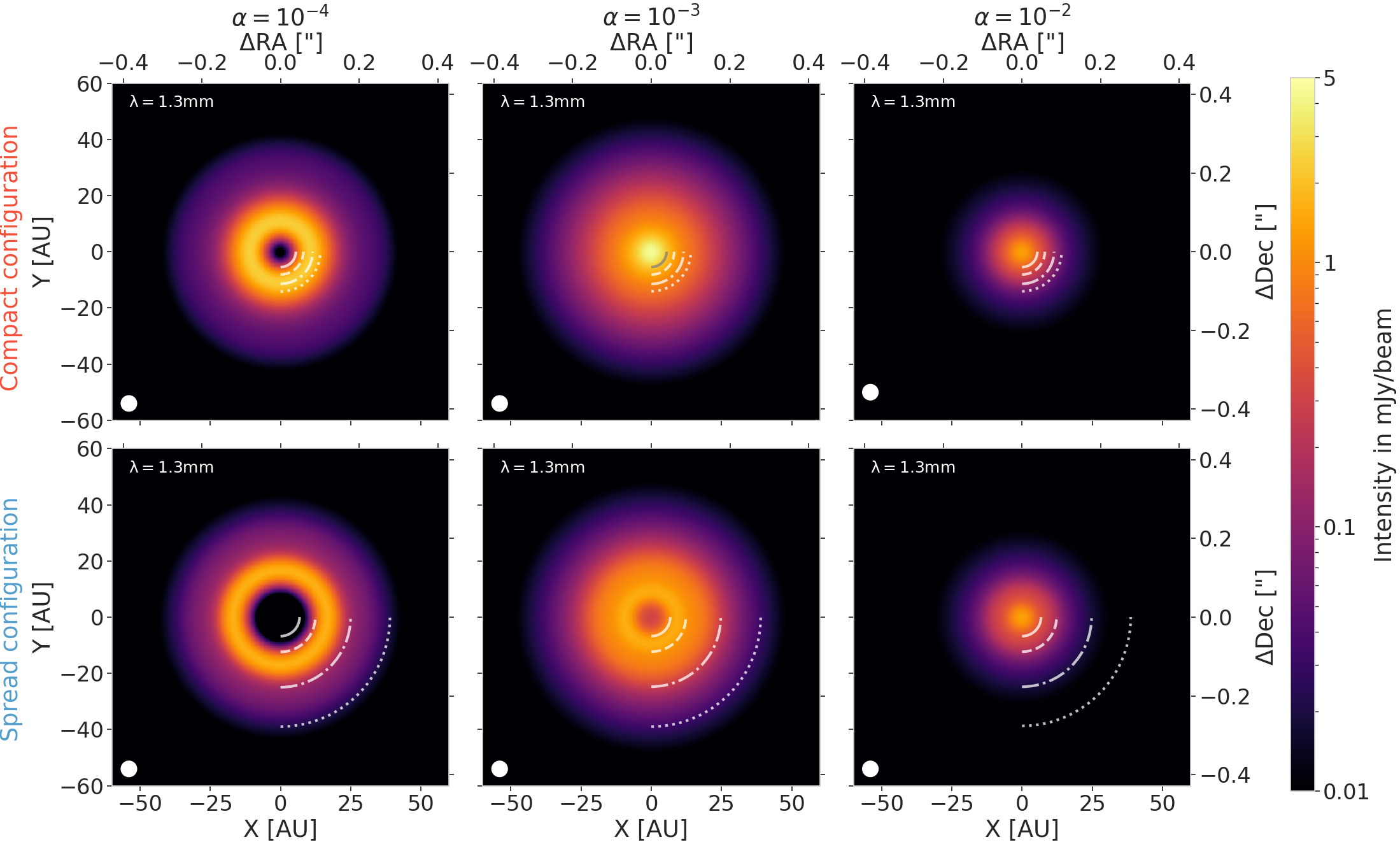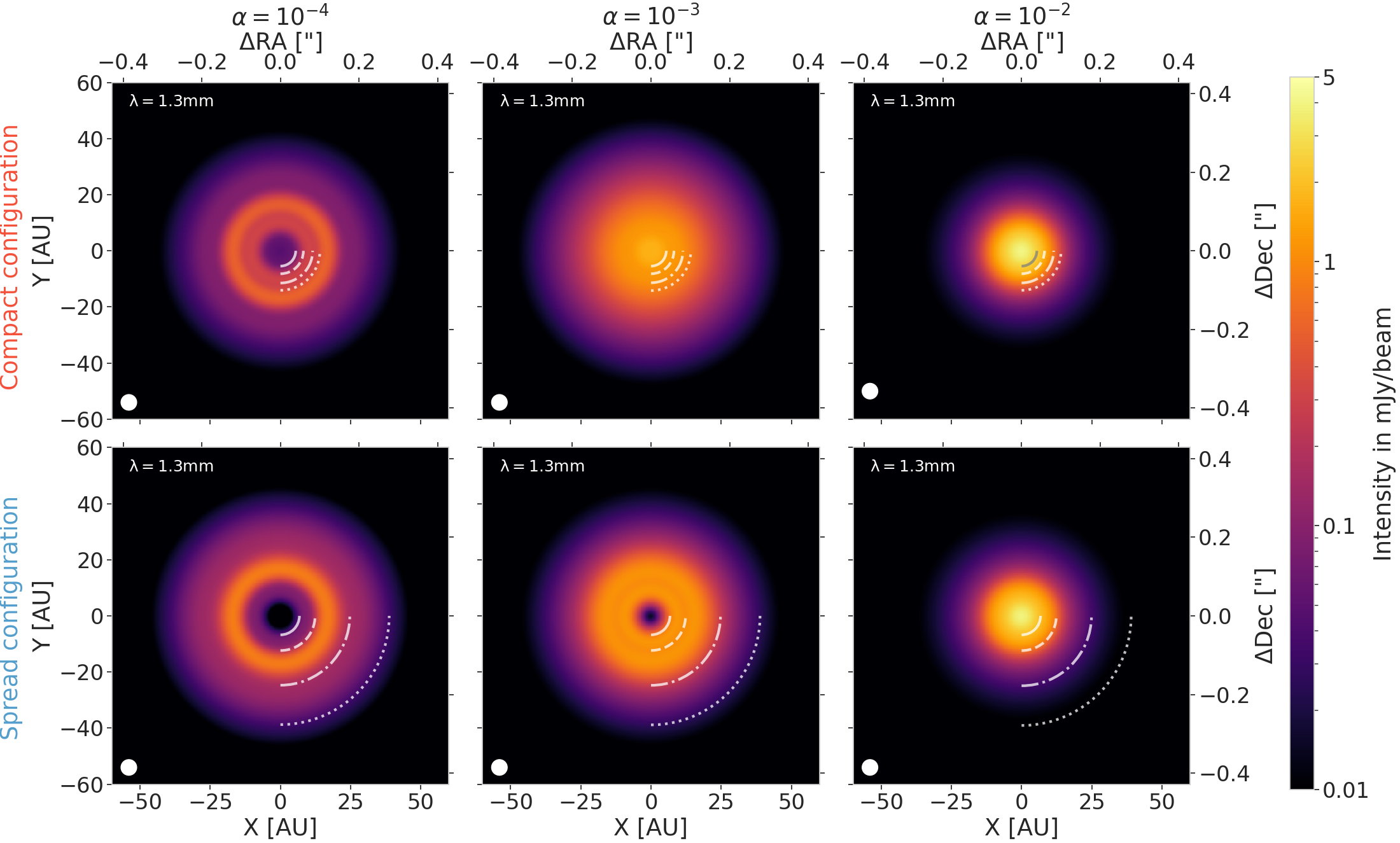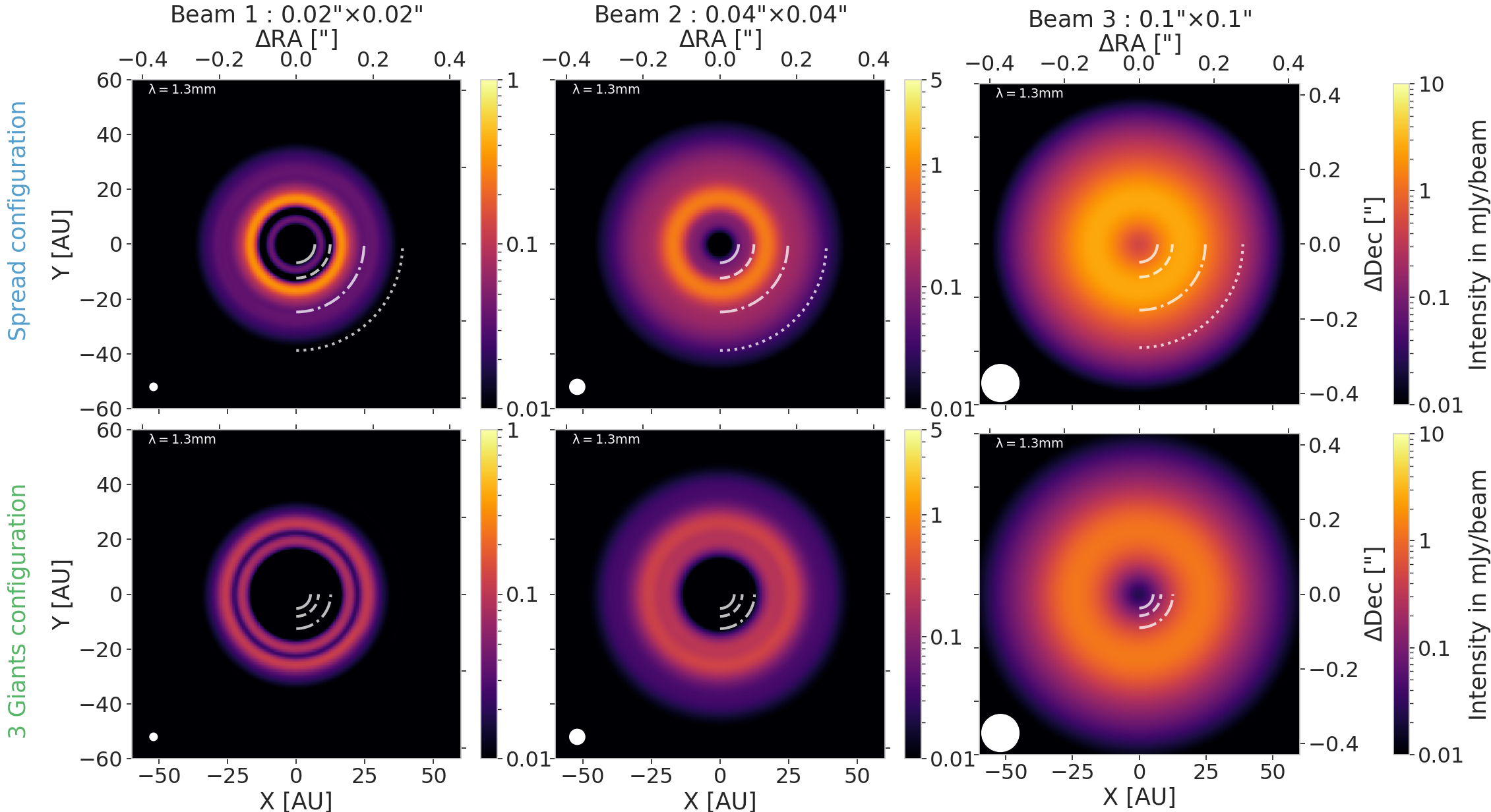Constraining giant planet formation with synthetic ALMA images of the Solar system’s natal protoplanetary disc
C. Bergez-Casalou, B. Bitsch, N.T. Kurtovic, P. Pinilla
Mar. 2022 - published in A&A - arxiv:2201.03383
Paper Abstract
New ALMA observations of protoplanetary discs allow us to probe planet formation in other planetary systems,
giving us new constraints on planet formation processes. Meanwhile, studies of our own Solar System rely on constraints derived in a completely
different way. However, it is still unclear what features the Solar System protoplanetary disc could have produced during its gas phase. By running
2D isothermal hydro-simulations used as inputs for a dust evolution model, we derive synthetic images at millimeter wavelength using the radiative
transfer code RADMC3D.
We find that the embedded multiple giant planets strongly perturb the radial gas velocities of the disc. These velocity
perturbations create traffic jams in the dust, producing over-densities different from the ones created by pressure traps and located away from the
planets positions in the disc. By deriving the images at λ=1.3mm from these dust distributions, we show that very high resolution observations are
needed to distinguish the most important features expected in the inner part (less than 15AU) of the disc. The traffic jams, observable with a high
resolution, blur further more the link between the numberof gaps and rings in discs and the number of embedded planets.
We additionally show that a system capable of producing
eccentric planets by scattering events that match the eccentricity distributions in observed exoplanets does not automatically produce bright outer rings
at large radii in the disc. This means that high resolution observations of discs of various sizes are needed to distinguish between different giant planet
formation scenarios during the disc phase, where the giants form either in the outer regions of the discs or in the inner regions. In the second scenario, the discs do not
present planet related features at large radii.
Finally, we find that, even when the dust temperature is determined self consistently, the dust masses
derived observationally might be off by up to a factor 10 compared to the dust contained in our simulations due to the creation of optically thick regions.
Our study clearly shows that in addition to the constraints from exoplanets and the Solar System, ALMA has the power to constrain different stages of
planet formation already during the first few Myrs corresponding to the gas disc phase.
Context and setup
The study of the formation of giant planets relies a lot on the constraints derived from the observations of their birth environment: the protoplanetary disc. When other planet formation constraints are derived from the local study of our own Solar System (e.g. study of meteorites), it is not easy to link the characteristics of these observed discs to the birth environment of our Solar System. Our goal here is to improve this link by deriving synthetic (i.e. theoretical) images of the hypothetical protoplanetary disc which formed our Solar System. In order to do so, we use numerical simulations to derive with FARGO2D1D how the protoplanetary disc gas is distributed when it's pertubed by the presence of the 4 giants of our system: Jupiter, Saturn, Neptune and Uranus. Knowing this, we are able to derive with TWOPOPPY how dust grains grow and distribute in such environment. The synthetic images are the output of a radiative transfer code called RADMC3D, which determines how much light such a system emits. We finalize the images by convolving the radiative transfer image with the beam of the simulated instrument: here, ALMA.

We explore different configurations for the positions of the giants, corresponding to different possible formation scenarios for our Solar System:
- In the Compact configuration, the planets are located at the positions needed to trigger the Giant planet instability (also known as the Nice instability ). The giants are located between 5 and 15 AU.
- In the Spread configuration, the planets are located further away from their nowadays positions, assuming that they will slowly migrate inward by the end of the gaseous disc lifetime. Here, the giants are located between 6 and 40 AU.
- In order to compare more easily to exoplanetary systems, we also investigate the structure of a disc hosting 3 Giants of 1 Mj each, located between 5 and 15 AU.
Initially: All the giants are slowly introduced in the gaseous discs until they reach they final mass (no accretion). They are also radially fixed in the discs (no migration nor dynamical interactions). We explore different disc viscosities by changing the alpha-viscosity parameter and the aspect ratio. The dust evolution model is run for 1 Myr, during which we expect the gas to be constant.
Output: The radiative transfer images are convolved with an ALMA beam of 0.04"x0.04", unless mentioned otherwise. It corresponds to the resolution used by the DSHARP survey . We analyze the presence and shape of substructures depending on the planet configuration and disc parameters (alpha-viscosity and aspect ratio).
Main results
As expected, when the viscosity is intermediate or large (middle and right columns in the following plots), the discs show very few substructures. However, at low viscosity, we start to observe gaps and rings. The orbits of the planets are represented by the white arcs. When the aspect ratio is large (MMSN like), the low viscosity discs show a single gap and a ring. Their position are not clearly linked to the positions of the giants.

On the other hand, when the aspect ratio is smaller, the low viscosity discs show multiple gaps and rings. In the Compact configuration, the different gaps and rings are not really correlated to the positions of the giants: the inner cavity is linked to the position of Jupiter and the outer ring is matching the position of Neptune but that's it. In the Spread configuration, the ring is clearly located between Saturn and Uranus and again the inner cavity is linked to the position of Jupiter.

We also investigate the impact of the resolution on the observability of the substructures. Here, we show the discs with low alpha-viscosity and low aspect ratio as they present the most contrasted substructures, in the Spread and 3 Giants configurations. In the middle column, we show the image with the previous 0.04"x0.04" beam.

On the right, the beam is larger, corresponding to a widely used resolution: the beam is 0.1"x0.1". In this case, only the inner cavity is visible. However, on the left, we show the images for one of the highest resolution ALMA can reach: the beam is 0.02"x0.02". Here, the image respresent well the main substructures of the discs. In the Spread configuration, we can distinguish the ring present between Jupiter and Saturn as well as the gap formed by the presence of Uranus. In the 3 Giants configuration, the planets create a large inner cavity around them. They also present a double ring located outside of the furthest planet.
Consequences
Comparison to observed discs : compared to other observed discs, as for example in the DSHARP survey our dust discs are small (less than 60 AU). These larger observed discs present gaps and rings at large radii (e.g., more than 50 AU in AS209 and HD163296). In their paper, Lodato et al. 2019 show that with giant planets migrating fast enough, it is possible to produce gaps and rings at large radii and still reproduce the distribution of eccentric giant planets observed in radial velocity. However, such migration speeds require a too high viscosity, as shown by Ndugu et al. 2019 , compared to the viscosity needed to allow the formation of planets that could explain the observed substructures. On the other hand, it is also very unclear how planets can form that far in discs with the core accretion model. As our setup contains systems that can match the characteristics of the observed giant planets after the gas disc dispersal, we conclude that the observations of smaller discs in the future can help us constrain the formation pathway of giant planets (e.g., under which conditions would they form in the outer or inner regions of the discs). Traffic jams : the presence of the double ring outside of the outer planet in the 3 Giants configuration is linked to the presence of dust traffic jams. The gas in the disc is highly perturbed by the presence of the 3 giants. Therefore, the radial velocity of the gas is perturbed, making the gas to slow down at some locations. The dust is following the gas and is also slown down, creating this second over density. The number and location of rings is therefore not directly correlated to the planets, making our interpretation of the observations more complicated. Dust masses : we also investigate how much dust remains in the disc after 1 Myr of dust evolution. By comparing the result from our simulations to the estimate made based on the images, we find that the lack of knowledge of the properties of the dust (such as opacity and temperature) can lead to an observed dust mass that is 10 times lower than the actual dust mass. This has important consequences regarding the estimations of the solid mass needed to form planets.